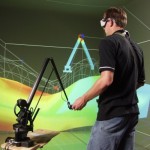Overview
The typical steps in the traditional product design process involve designing a shape, selecting materials, performing analysis, building prototypes, and testing. Numerous iterations are performed at several steps in the process in order to achieve a suitable design. When trying to optimize the design based on shape or material properties, these iterations can often be time consuming. This limits the number of design possibilities that can be explored because of the desire to decrease design time.
After an engineer designs a part ultilizing computer aided design, he or she will typically run a finite element analysis (FEA) on the part to determine its reliability. If the results from the FEA indicate that the part will fail and must be re-designed, the engineer redesigns the part and re-runs the FEA. This continues until the design is acceptable. The time required to run the FEA hinders the ability of the engineer to experiment with different designs. This research project seeks to give the engineer a tool that will allow him or her to interactively change the design and immediately see the FEA results. The re-design process is done in virtual reality because it allows the engineer to use natural head and hand motions to view the results and modify the design.
An application has been created to implement and test such interactive design methods. It combines several features into a virtual reality program including:
- Imported CAD geometry
- Engineering analysis results using Reproducing Kernel Particle mesh-free methods
- Real-time shape manipuation with NURBS free-form deformation and subdivision volumes
- Two fast analysis approximations: linear Taylor series and Preconditioned Conjugate Gradient reanalysis
- Haptic feedback based on stress levels via a PHANToM device
Research continues into several areas of improvement including: adding automatic optimization routines to the interactive design process, implementing additional element types such as plates and shells, working with more advanced material models, and approximating non-linear analyses. The program also has the ability to interface with the Tahoe analysis software to support a variety of analysis types.
Media
- Video: clip of stress reanalysis in virtual reality [Quicktime MOV, 63M]
- A subdivision volume used to deform parts in the application [PNG, 91K]
- Several models shown in VR [JPEG,34K]
Publications
- Faas, D., A. Fischer, Vance, Judy M. (2007). Interactive Mesh-Free Stress Analysis for Mechanical Design Assembly with Haptics. ASME International Design Engineering Technical Conferences and Computers and Information in Engineering Conference, Las Vegas, NV.
- Fischer, A. and J. M. Vance (2003).PHANTOM Haptic Device Implemented in a Projection Screen Virtual Environment. 7th International Immersive Projection Technologies Workshop.Zurich, Switzerland.
- Fischer, A., Vo, Dao M, Vance, Judy M., (2007). Haptic Feedback To Guide Interactive Design. Presence: Teleoperators and Virtual Environments.
- Fischer, A. and J. M. Vance (2007). Fast Mesh-Free Reanalysis with Open Source Software for Virtual Design. AIAA Journal.
- Fischer, A. and J. M. Vance (2007). Interactive Manipulation of Mesh-Free Models in Virtual Reality. ASME Journal of Mechanical Design.
- Fischer, A. and J. M. Vance (2007).Stress Sensitivity Calculation Methods for Interactive Mesh-Free Reanalysis. Computer Modeling and Simulation Engineering.
- Chipperfield, K., Vance, J.M., Fischer, A.(2006) Fast Meshless Reanalysis Using Combined Approximations, Pre-Conditioned Conjugate Gradient, and Taylor Series, AIAA Journal.
- T.P. Yeh and J.M. Vance (1998). Applying Virtual Reality Techniques to Sensitivity-Based Structural Shape Design. ASME Journal of Mechanical Design, 120[4], pp. 612-619
- Chipperfield, K., Yeh, T-P, Vance, Judy M.(2002). Interactive Product Development in a Virtual Environment Utilizing Haptics. 2002 NSF Design, Service and Manufacturing Grantees and Research Conference Proceedings, San Juan, Puerto Rico, January 7-10.
- Chipperfield, Kurt (2002) Interactive stress re-analysis in virtual reality, Ph.D. Thesis, Iowa State University.
Personnel
- Dr. Judy M. Vance, Professor, Iowa State University
- Daniela Faas, Graduate Research Assistant
- Andrew Fischer, Graduate Research Assistant
- Andy Mckean, Graduate Research Assistant
- Kurt Chipperfield, Graduate Research Assistant
Funding
- Procter and Gamble
- Previous work has been funded by the National Science Foundation.
